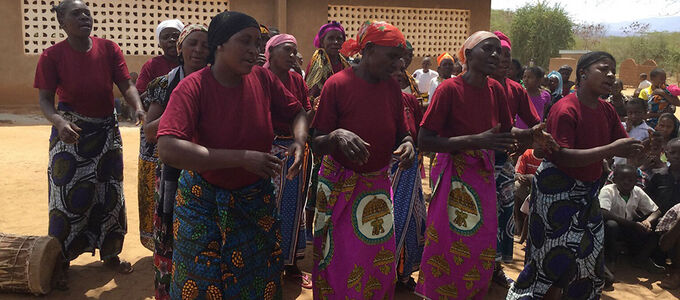
It all started at the end of the 1970s, when ministers from Zambia, the USA, Germany, and Kenya came to Tanzania to bring the New Apostolic faith to the African nation. This weekend, the Chief Apostle will be visiting a country with more than a quarter million Church members.
Justin Mwegoha earned his living with a small carpentry business. In January 1981, he was working on a furniture frame in front of his workshop when he was approached by three men. They introduced themselves as District Evangelist Donald Kratt from the USA and Shepherd Adolf Eichsteller from Germany. And the youngest of the three was a fellow countryman by the name of Zacharia Deuly. The men told him about living Apostles and the love of God, and went on to explain that Jesus Christ would soon return. They also invited him to a guest service.
Justin Mwegoha, who was very impressed by what he had heard, asked where the service would take place and who was to attend. The strangers replied that he was to rent a room and invite his relatives and friends. That same evening, a service with 30 guests took place in a school classroom. Justin Mwegoha translated from English into Swahili and later became the first Apostle for Tanzania, together with Mathias Nzarombi.
Rapid development
As early as 1978, two District Evangelists from the neighbouring country of Zambia travelled to Tanzania and registered the New Apostolic Church as a religious organization in the country’s largest city, Dar es Salaam. By 1979, the Church was officially registered in Tanzania, and one of its first members, Zacharia Deuly, diligently helped to spread the faith in his country.
Meanwhile, District Apostle Michael Kraus sent Apostle Vovak from the USA to the East African country, which borders the Indian Ocean and Kenya, Uganda, Rwanda, Burundi, the Democratic Republic of Congo, Zambia, Malawi, and Mozambique. So it was that ministers from the USA and Germany as well as ministers from Zambia were all doing missionary work in Tanzania at the same time.
The number of members of the New Apostolic Church in Tanzania quickly increased, ministers were ordained, and seminars were conducted. In 1983, for example, Apostle Simon Anokoli conducted 32 services on his thirteen-day trip through Tanzania, during which he dispensed the sacrament of Holy Sealing to a total of almost 2,500 people. In order to reach the most remote places in the country, the ministers chartered private planes.
The Church in figures
By the end of 1983, the New Apostolic Church in Tanzania numbered some 10,000 members in 151 congregations. It was served by two of its own Apostles as well as many other ministers.
Today the country is home to over 266,000 members in approximately 2,000 congregations. More than 4,000 ministers support twelve Apostles in providing pastoral care to the believers.
A wealth of history, nature, and languages
After colonial occupations by Germany, England, and Belgium, the area where Tanzania is today located became independent on 9 December 1961. Tanganyika (Tan) and Zanzibar (Zan) merged on 26 April 1964, initially under the name “Republic of Tanganyika and Zanzibar”, but from 1 November 1964 onward, the state became known as the United Republic of Tanzania.
Tanzania boasts tropical vegetation near the coast as well as savannahs further inland. The country is famed for the Kilimanjaro massif with Kibo as the highest mountain in Africa, as well as the East African Rift that runs through its centre. Other well-known features include Lake Victoria on the border with Uganda and Kenya, as well as the Serengeti Desert.
In total, there are about 125 languages spoken in Tanzania. Some 90 percent of these are Bantu languages, which often feature certain similarities. One of these, Swahili, is the de facto official language of the nation, but English is also frequently spoken.
Eight special congregations
Of the country’s 62 million inhabitants, most are very young, and a large proportion are of African descent. But there are also people whose ancestors immigrated from Arab countries centuries ago, as well as a few remaining descendants of European settlers. Hundreds of thousands of people presently live in Tanzania because they had to flee their own countries of origin as a result of political crises and wars that have unfolded there. Most of them come from Burundi and the Democratic Republic of Congo.
For example, Ayumba Eca Christophe from the Democratic Republic of Congo lives in one of the largest and best-known refugee camps, the Nyarugusu Refugee Camp in Kigoma. Approximately 150,000 refugees currently live there on an area of around 2,000 hectares. They include some 3,800 New Apostolic brothers and sisters who attend divine services in eight congregations with church buildings of their own, where they receive pastoral care from Priests like Christophe.
Congregations the Chief Apostle will visit
During his visit, Chief Apostle Jean-Luc Schneider will hold a service in each of the country’s two largest cities, namely Dar es Salaam and Mwanza. He will be in Mwanza on Friday, 16 August and in Dar es Salaam on Sunday, 18 August.


















